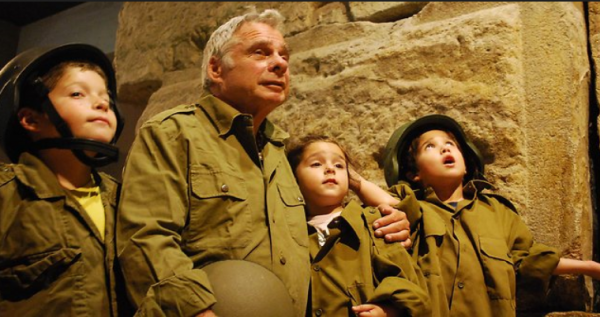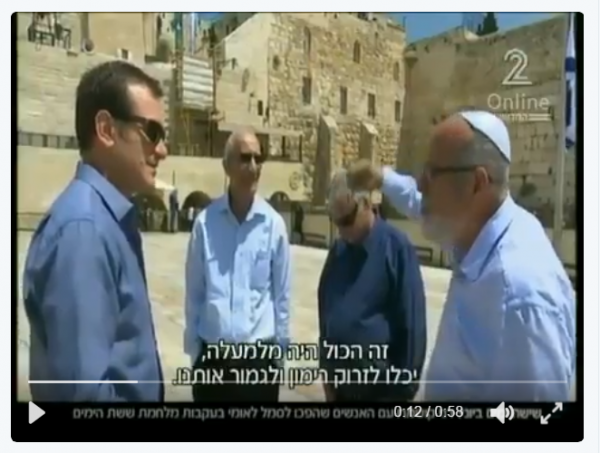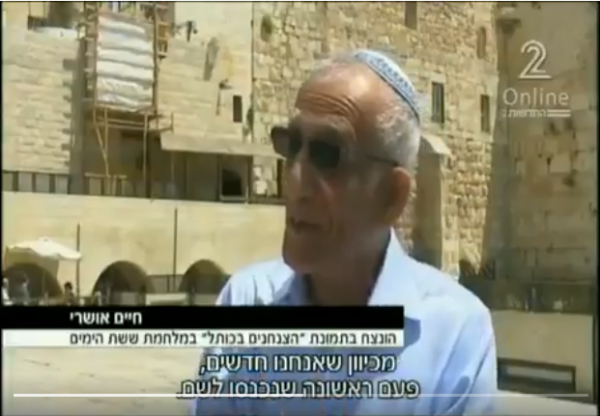Three Israeli Paratroopers Reenact Their Iconic 1967 Western Wall Liberation Photo
Recreating the Moment Paratroopers Liberated Jewish Jerusalem, 50 Years Later
Last week, the three Israeli paratroopers whose images were photographed as they stood in silent awe in front of Jerusalem’s Western Wall (the Kotel) shortly after its capture during the Six-Day War returned to the Old City to remember the moment and reenact the famous picture.
In prior posts, we highlighted how on June 7, 1967 the three 20-something reserve duty soldiers—Zion Karasenti, Haim Oshri, and Yitzhak Yifat—inadvertently became the symbols of the Jewish people’s fulfilment of a 2,000 year old dream when the Kotel and the many other Jewish holy sites in east Jerusalem were liberated from an unjust and unlawful Jordanian occupation.
As we noted, it happened when the late David Rubinger, a savvy photographer at the start of his career, also happened to be at the right place at the right time. He managed to capture what became the defining image of Israel’s extraordinary 1967 military victory and one of the most significant moments in modern Israeli and Jewish history:
- Jerusalem Reunited 1967: Three Israeli Soldiers, One Iconic Photo
- RIP David Rubinger: Israel’s Iconic Photographer Dies at 92
Now, with the 50th anniversary of the Six Day War approaching, the three men—all in their seventies—recalled the events of that fateful day to Israel’s Channel 2 News.
Three Friends Reenact Famous Photograph of “Paratroopers at the Western Wall” Nearly 50 Years Later
As we highlight in our earlier posts, over the years Karasenti, Oshri and Yifat have returned periodically to the Western Wall to recreate the iconic picture that launched Rubinger’s legendary career.
[Original June 7, 1967 Photo | Credit: David Rubinger]

Credit: YNet
Last year too, Yifat came with his three grandchildren—Matan (11), Oz (5) and Shira (3)—to recreate the image:

[Yitzhak Yifat with his grandchildren | May 2016 | Credit: Mia Dubinsky, YNet]
But with Jerusalem Day 2017 only a few weeks away, marking a half century since the Old City and historic Jewish sites returned to Jewish sovereignty, Yifat, Karasenti and Oshri’s pilgrimage to remember their iconic war photo is once again newsworthy.
Here’s the Channel 2 News four-minute interview with the three former soldiers. It isn’t translated into English, but the Times of Israel provides a synopsis of much of what was said:
With the 50th anniversary of the Six Day War approaching, Zion Karasenti, Haim Oshri, and Dr. Itizik Yifat returned to the Old City this week to remember the moment.
Karasenti, Oshri, and Yifat described to Channel 2 News how they, as 20-something reserve duty soldiers, inadvertently became the symbol of a nation fulfilling a 2,000 year dream.
“There were snipers everywhere, especially from overhead. They could have thrown a grenade on us and finished us,” Karasenti recalled of the battle for the Jerusalem holy site.
Since none of them had ever been to the Western Wall, which had been under Jordanian rule since 1948, they admitted that, at first, nobody was really sure they had even captured the “real thing.”
“Everyone talked about the Kotel [Western Wall] all the time, but we were new and we had never been there. That day was the first time any of us had ever been there,” Oshri said.
At the time there was only a narrow corridor separating the Western Wall of the Temple Mount from the nearby houses and buildings of the Old City.
“When they [our colleagues] raised the flag over the Western Wall, that was our sign,” Karasenti said.
50 שנה אחרי מלחמת ששת הימים, הלוחמים שהפכו לסמל משחזרים את המערכה ששינתה את פני המדינה. לכתבה המלאה: https://t.co/DHxQzyOlaj pic.twitter.com/EHHYTQxIg7
— החדשות – N12 (@N12News) April 29, 2017
You can view the full video here.
Of particular relevance, because it’s not something any of the men noted in prior interviews, is Karasenti’s recollection of snipers being “everywhere, especially overhead.” Speaking to the news reporter, Karasenti says that the snipers could’ve “thrown a grenade and finished us off.” Here’s the screenshot of that part of the interview:

When the reporter asks whether they realized right away that they were standing at the Kotel, Oshri explains that it was difficult to make sense of where they were because at the time there was only a narrow 4 meter corridor separating the Kotel from the nearby Arab houses and buildings. He notes that as newcomers to the area, it was the “first time we had ever entered there”:

Karasenti said that it was only when the Israeli flag was raised over the Kotel that they had a “sign” that the IDF had indeed captured the “real thing.”
He added that after two days of battle, they were all tired and sweaty but “when we walked down the stairs and saw the stones of the Western Wall, a lot of the guys started crying. It was a precious thing. It’s hard to even describe it.”
Beyond the meaningful recollections of that fateful moment, it’s touching to see that three men have remained good friends over the years.
As noted in our prior post, despite finding themselves shoulder-to-shoulder on that momentous day in June 1967, Karasenti, Oshri and Yifat came from very different walks of life.
So there’s little reason to expect that they would’ve remained close.
In fact, during the interview they appear to have some political disagreements—of the three, Yifat is more left-of-center and a harsh critic of Israeli settlements in Judea and Samaria/the West Bank. Yifat and Karasenti even get into a brief argument over the ‘occupation’.
But these political differences haven’t soured their friendship. If anything, to my mind they seemed even closer at last week’s reunion than they did in interviews conducted in prior years.
Conclusion
Yitzhak Yifat, Zion Karasenti and Haim Oshri, forever immortalized by a defining photograph of the 1967 war shot at the Western Wall on June 7, 1967, recognize that they have become a “symbol of Israel’s strength.” Along with their fellow paratroopers of the courageous 55th Brigade, in last week’s interview the three men agreed that they had “returned the heart of the Jewish people to the land.”
Most Jews can appreciate what they accomplished. In previous years when they came to the Kotel to recreate the iconic image, worshippers would invariably come up to them to express their gratitude.
That happened last week too.
As the three men approached the Kotel to take the photo, a passerby reportedly stopped the three to thank them:
All of the people that are here right now are only here because of you. It’s you, and all of the other soldiers who fought then. This is all thanks to your courage and your faith. So again, thank you so much.”
[From L to R, Haim Oshri, Yitzhak Yifat, and Zion Karasenti | “Their strength & their belief. Thank you very much, thanks.” | Translation mine]
Feature Image: Israeli army paratroopers Zion Karasenti, left, Yitzhak Yifat, center, and Haim Oshri, right, stand next to the Western Wall (the Kotel) in Jerusalem’s Old City in April 2017.
Miriam F. Elman is an Associate Professor of Political Science and the Robert D. McClure Professor of Teaching Excellence at the Maxwell School of Citizenship & Public Affairs, Syracuse University. She is the editor of five books and the author of over 60 journal articles, book chapters, and government reports on topics related to international and national security, religion and politics, and the Israeli-Palestinian conflict. She also frequently speaks and writes on the Boycott, Divestment, and Sanctions (BDS) anti-Israel movement. Follow her on Twitter @MiriamElman
 DONATE
DONATE
Donations tax deductible
to the full extent allowed by law.








Comments
Islam is responsible for it all.
Islam === I Slam (everything and everybody)
Absolutely EPIC! Great to see heroes remembered as heroes.
The right of conquest is enshrined in international law. If you don’t believe me, try to find Konigsberg on a map. It’s not there.
When you are unlawfully and unjustly attacked, and you seize enemy territory as a result of the unlawful and unjust invasion, you keep it. Which is why there is no longer a Konigsberg but a Kaliningrad. As vile as Stalinist USSR was, they won it from the Nazis fair and square.
There is no comparison. The Israelis are the most kind and compassionate people on earth, totally unlike the Stalinists. I am ashamed of my government for even allowing the suggestion of a a comparison.
The official story is that international law on this changed with the adoption of the UN Charter. So Poland’s annexation of half of Prussia is legal, but Israel’s annexation of Jerusalem and the Golan is not. Rather convenient, that cutoff date, huh? Of course it’s all BS.
It reminds of the leftist propaganda practice to say that since 9/11 Christian fanatics have killed more Americans than Muslim extremists.
I will not go into the myriad flaws of the argument, simply one.
Very convenient, isn’t it, the starting point? Baby ducks, history didn’t start until 9/12/2001. The math still doesn’t work out, but they tried their damnedest to skew things in their favor.
I’ve heard how everything in the Muslim theology of victimology must be blamed on the Crusades (and I realize you have your own issues, Milhouse). I fail to see how the the first Crusade which wasn’t ordered until 1095 explains the Saracen sack of the environs of Rome in 846 or the battle of Tours in 736.
I could go on. But I think you get my point. I’m sick of the “But the Bible” crap that atheist jihad deniers imagine is so devastating.
Masada must not fall again. Masada will not fall again.
732. That was the Battle of Tours. 736 was when the Saracens established a beachhead at Narbonne. The point still stands. The Muslims were @$$holes centuries before Christendom launched the admittedly indefensible Crusades.
This isn’t to say that a military response to four hundred years of jihad wasn’t justified. I’m not saying that.
Then there are the two others in the 1967 picture that are not named, one full face one partial.
Those two could have at least been named.
No doubt.